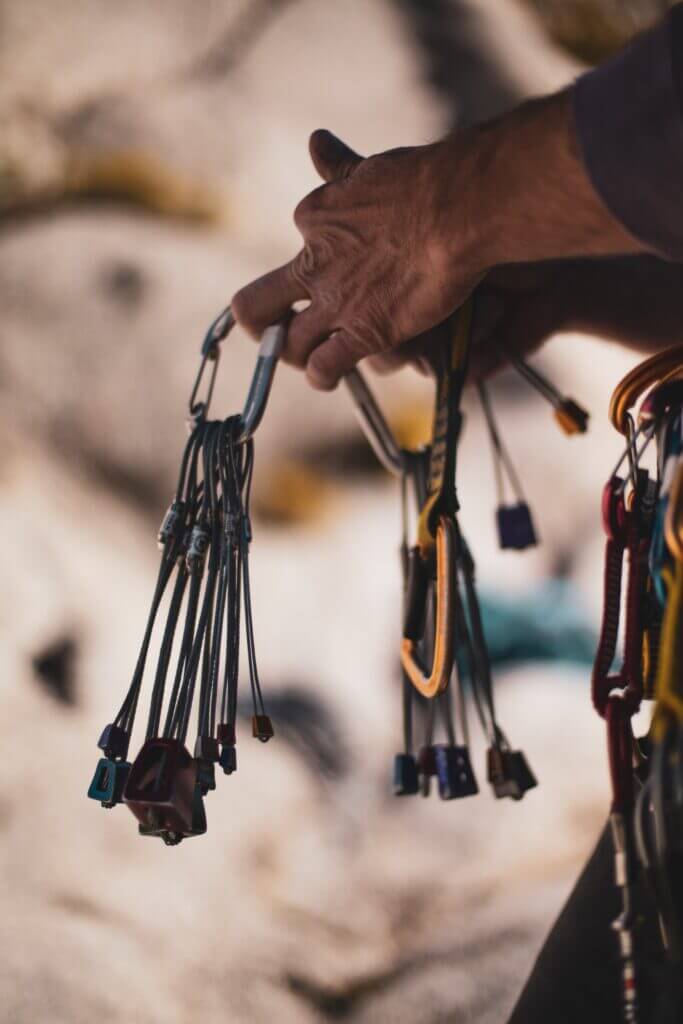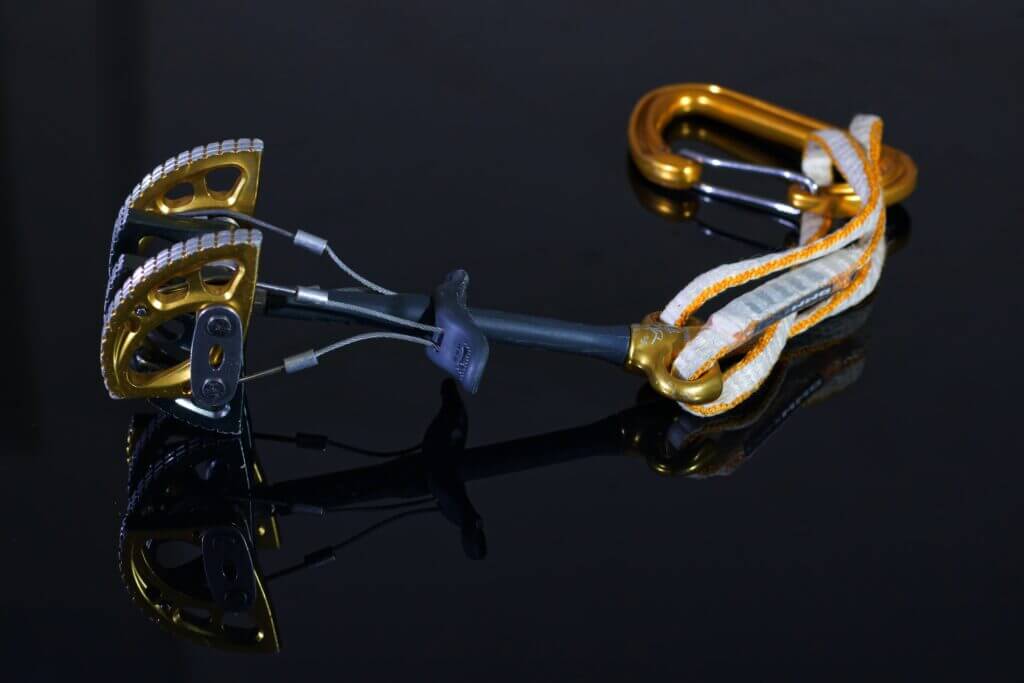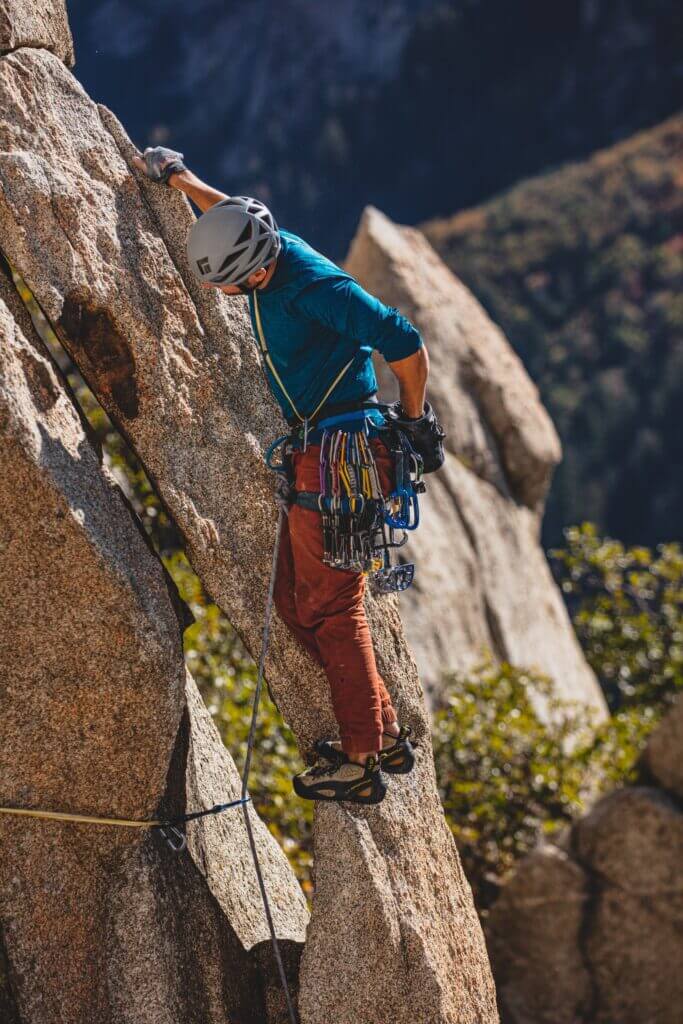There are many styles of rock climbing– trad climbing is just one of them. Styles range from relatively low-commitment indoor gym climbing to massively risky objectives in the big mountains. Selecting a preferred style of rock climbing depends on what you want to learn and your relationship with risk.
Trad climbing fits the bill for those who enjoy learning about the subtleties of climbing gear, the nuances of climbing slower and more methodically, and being able to ascend a cliff or mountain with only the equipment attached to their harness when they leave the ground.
Sounds intriguing. Curious to learn more about trad climbing? Read on!
What Exactly is Trad Climbing and Where Does it Come From?
Trad climbing, which is short for traditional climbing, is a style that does not rely on fixed gear, like bolts, to protect a climb. Instead, traditional climbing relies on personally placed removable gear to protect the lead climber and build anchors.
After the lead climber finishes the pitch, the second climber, removes the protection as they climb the route. The protection gear can then be used again for the next pitch or another climb.
A Brief History of Trad Climbing
In many ways, traditional climbing is the evolution of aid climbing. Aid climbing is a style of climbing that relies on devices attached to fixed pieces of protection to make upward progress.
Many old aid routes have been free-climbed without aid gear due to improvements in modern trad gear. Specifically, because trad protection has improved– normalizing falling and allowing climbers to push the limits of the sport.
Until the mid-1980s, trad climbing was the dominant and most popular form of free climbing. However, since then, sport climbing and competition climbing, along with indoor climbing, have become more popular due to their fewer barriers to entry.
Despite the barriers to entry, the largest of which is purchasing and learning how to use trad climbing gear, traditional climbing continues to be one of the purest forms of climbing.
Trad Climbing Gear
Unlike sport climbing, trad climbing does not rely on protection bolts. Instead, climbers place their own protection into cracks in the wall. Then, they clip their rope to the piece of gear so it will catch them if they fall, so long as it’s properly placed and the rock quality is good.
Some trad routes may have the occasional bolt in otherwise unprotectable sections of rock, normally on faces of rock without cracks. Trad routes may also have relics from old aid ascents that have not been removed, such as pitons.
Generally speaking, there are two types of traditional climbing protection– passive and active protection.

Passive Protection
Passive climbing protection has no moving or mechanical parts. This category of gear includes stoppers and hexes (and tricams when placed in their passive orientation).
Passive protection like stoppers are placed into cracks like a chockstone. The placement quality will depend on the surface contact between the stopper and the rock and the rock quality. When properly placed and a climber falls onto passive gear, it wedges deeper into the rock, essentially becoming trapped, and arrests the fall.
Active Protection
On the other hand, active protection does have moving and mechanical parts. This category of gear includes camming devices.
Camming devices are placed into cracks by engaging the trigger. Pulling on the cam’s trigger activates the mechanism, making the cam smaller. After the cam is placed and the triggers are released, the cam expands into the crack to add security.
The quality of a cam placement depends on the surface contact of the cam’s lobes with the rock and the rock quality. When properly placed and called on, the cam expands further into the crack, gripping it and arresting the fall.

Other Pieces of Trad Climbing Equipment
Besides the passive and active pieces you need to protect a climb and build anchors, you’ll also need a selection of other critical pieces of trad gear.
- Non-locking carabiners: utilized for non-critical linkages, like attaching gear to your harness.
- Locking carabiners: utilized for critical linkages, such as the masterpoint of an anchor, belay device, or personal tethers.
- Extendable quickdraws: also known as alpine quickdraws, extendable quickdraws are used for extending a placed protection piece and attaching the climbing rope.
- Sewn slings: also known as runners, slings are sewn loops of solid material, most often Dyneema, that come in various lengths. They are helpful in many scenarios, such as building anchors and creating a rappel extension.
- Accessory cord: also known as cordelette, accessory cord is vital for building anchors. Between 16 and 20 feet is recommended, with a diameter no smaller than 6mm.
- Nut Tool: a nut tool is a specialized piece of equipment designed to assist you in removing stoppers.
- Climbing helmet: wearing a climbing helmet protects you from falling overhead hazards, such as rock fall, and from hitting your head during a severe fall. Helmets can mitigate risk but do not make trad climbing safer.
Is Trad Climbing Safe?
Trad climbing can never be safe. Trad climbing can only be more or less risky. Mitigating risk while trad climbing is all about climbing within your ability, making conservative decisions, placing good gear, and building bomber anchors.
Climbers often assume that sport climbing and bouldering are “safer” forms of climbing than trad climbing. However, sport climbing, like all climbing styles, is inherently dangerous and unsafe.
With that being said, there tends to be more risk involved in trad climbing. Sparse opportunities to place gear, bad rock, incorrectly placed gear, and inadequate anchors each increase the inherent risk of trad climbing.
How To Get Into Traditional Climbing
The best way to get into trad climbing is slowly and methodically.
- Before lead climbing, follow experienced climbers to learn about cleaning gear placements.
- Refine your gear placing abilities in cracks you can access from the ground.
- Similarly, master building anchors on the ground.
- When it’s time to lead, climb well below your physical ability.
- To learn to trust your gear, take practice falls on the gear you placed ( with a backup, of course).
- Hire a guide or take courses to learn trad climbing best practices.



